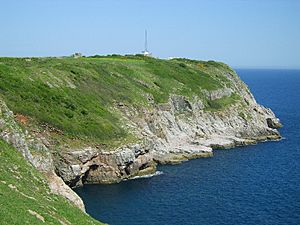Berry Head facts for kids
Berry Head is a special piece of land that sticks out into the sea in Devon, England. It forms the southern edge of Tor Bay. This area is east of the town of Brixham. Berry Head is a protected place, known as a national nature reserve and a local nature reserve. The whole area from Berry Head to Sharkham Point is also a Site of Special Scientific Interest, which means it's very important for nature.
Contents
Amazing Wildlife at Berry Head
Berry Head to Sharkham Point is a fantastic home for many rare and special plants and animals. These species need the thin, rocky soil, mild weather, and windy conditions found here to survive.
Seabirds and Migrating Birds
The tall cliffs at Berry Head are home to a large group of seabirds. You can see birds like guillemots, razorbills, and kittiwakes nesting here. Sometimes, very rare birds that have flown off course visit Berry Head. For example, a yelkouan shearwater was seen here in 2008, and a Hume's warbler in 2014.
The guillemot colony on the cliffs is one of the biggest on England's south coast. You can even watch them live on CCTV at the Visitor Centre! Berry Head is also a key resting spot for birds traveling long distances. It's also home to many cirl buntings, a type of bird that is quite special in Britain.
Unique Plants and Bats
Berry Head is one of only two places in Great Britain where you can find the white rock-rose, small hare’s ear, and small restharrow. Other special plants like spring gentian, honewort, and goldilocks aster also grow here. They all need the thin soil and exposed conditions of the headland to thrive.
The caves at Berry Head are home to the endangered greater horseshoe bat. To help these bats, a small group of North Devon cattle have been brought to the headland. Their droppings attract dung beetles, which are an important food source for young bats.
Old Forts and History
Berry Head was once the site of an Iron Age hill fort. This ancient fort was mostly taken down between 1794 and 1804. This was done to build strong fortifications to protect Tor Bay from possible attacks by French armies during the Napoleonic Wars.
Today, the old artillery house has a public display. Here, you can learn about the history of the area, its wildlife, and why it was such an important place for defense.
Helping Ships and Planes
Berry Head is also home to the Berry Head Lighthouse. This lighthouse helps guide ships safely along the coast. There is also a special beacon here called a VOR/DME beacon. This beacon is used to help with air traffic control, guiding planes in the sky.
The Old Hospital Building
The building that is now the Berry Head House Hotel was first built as a military hospital. It was used to support the three forts on Berry Head during the Napoleonic Wars. Later, it became the home of Henry Francis Lyte, a famous writer of hymns and poems. His family owned the house until 1949, when it became a hotel. Other notable people, like photographer Farnham Maxwell-Lyte and cricketer Evelyn George Martin, also lived or stayed at the house. A special plaque was put up in 2013 to remember Martin's time there.
Images for kids
See also
 In Spanish: Cabo Berry para niños
In Spanish: Cabo Berry para niños




